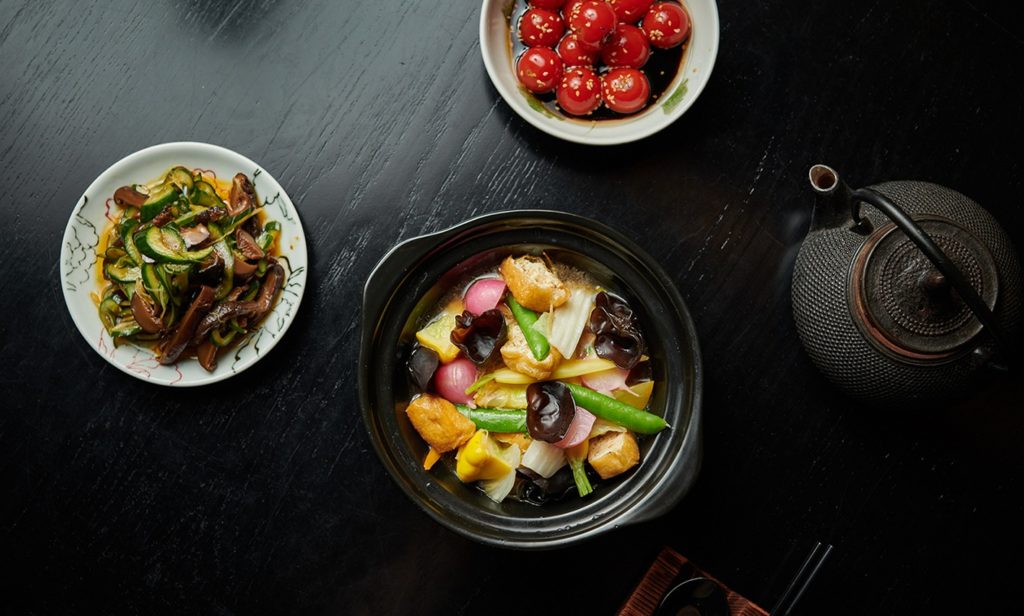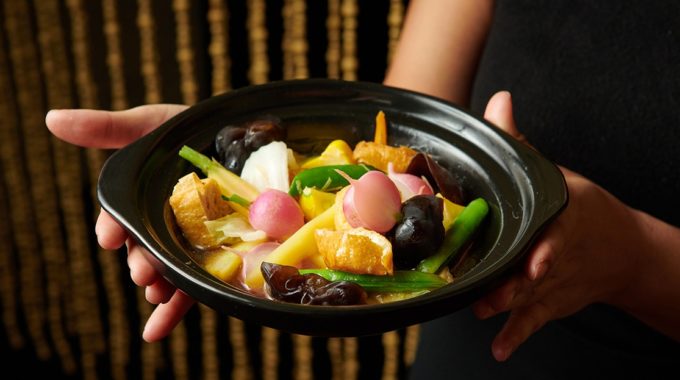Buddha’s Delight to bring you good luck
The Lunar New Year festival is in full swing. To help you usher in some good fortune in this Year of the Tiger, Spice Temple chef Josh Kerr has shared his recipe for Buddha’s Delight.
Our own New Year’s celebrations might have long passed, but the Lunar New Year has only just begun. Lunar New Year festivities begin on the first new moon of the lunar calendar, and end on the first full moon of the lunar calendar, 15 days later.
Sydney and Melbourne’s Spice Temple modern Chinese restaurants celebrate Lunar New Year with sumptuous banquets. As Spice Temple Executive Chef Andy Evans explains, Lunar New Year celebrations are all about ushering in good luck for the year ahead.
“The Lunar New Year is the most sacred festival in Chinese culture,” he says. “Family and friends traditionally come together to feast on foods that are symbolic of all they wish to achieve in the year ahead, while foods that are considered taboo are avoided.” (You can read more about the symbolism of traditional Chinese foods here.)

A feast of fortune
Evans and Spice Temple Melbourne Head Chef Joshua Kerr have curated special Chinese banquet menus to celebrate the Year of the Tiger. The special banquet menus have food symbolism at the fore. There are purse-shaped pipis that represent fortune, fish that symbolises life and abundance and eggs that signify fertility. There are also plenty of red ingredients, which stand for prosperity and happiness in traditional Chinese culture.
Evans explains that the symbolism of traditional Chinese New Year foods is embraced, and lucky foods are consumed during the annual celebrations. People do this to send off the old year and seek good fortune for the coming year.
“Our Chinese banquet menus have been designed with good luck in mind,” he says. “We like to think they will help bestow prosperity, happiness, peace, love and other aspects of good fortune on our guests in line with their Lunar New Year beliefs and rituals.”

Buddha’s Delight for luck and prosperity
At Spice Temple Melbourne, Kerr has included a dish called Buddha’s Delight, or Lo Han Jai. This quintessential Buddhist vegetarian dish is a highlight of Chinese New Year menus.
“Slow-cooked, incorporating a beautiful selection of vegetables and robust in flavours, Buddha’s Delight is traditionally eaten on the first day of the Chinese New Year,” Kerr explains. “It welcomes good luck and prosperity.”
After the past two years of COVID-related craziness, we could certainly all use a little extra luck. And so, to help you usher in some extra good fortune this Lunar New Year, Kerr has shared his special recipe for Buddha’s Delight with us. It includes shiitake and wood ear mushrooms for longevity, snow peas for unity and togetherness and ginger for good health.

Buddha’s Delight
Recipe by Joshua Kerr
You’ll need:
3 baby carrots
1 yellow squash
6 snow peas
4 pieces dried shiitake mushrooms (soak overnight)
4 pieces wood ear mushroom (fresh or dried)
Small thumb of ginger – peeled and julienned
4 pieces oyster mushroom
3 pieces puffed tofu, cut into halves
1 tsp castor sugar
2 tbsp Shaoxing wine
1 tbsp oyster sauce*
150ml chicken stock*
1 tbsp mushroom soy (Healthy Boy brand if possible)
2 tsp potato starch mixed with 20ml water
Sesame oil
Method:
To prepare the vegetables:
1. Thoroughly wash all vegetables and peel the carrots (if preferred, but not essential). Halve the carrots lengthways, quarter the squash and trim the tops of the snow peas.
2. Place a pot of water on to boil and lightly season with salt. Set up a bowl of iced water.
3. Blanch the carrots for 90 seconds then place in ice water to stop cooking. Repeat the process for the squash but cook for 60 seconds, then again for the snow peas for 30 seconds. Drain all the vegetables and set aside.

To cook the vegetables:
1. Ideally, soak the shiitake mushrooms overnight, then boil in a small saucepan until completely rehydrated and tender. Set aside and keep the cooking liquid. When cool enough to handle, remove the stems and cut into halves.
2. If using dried wood ear mushroom, cover with cold water and leave to rehydrate – around 15 minutes. Drain thoroughly, trim the base and cut if the pieces are particularly large. If using fresh wood ear mushroom, tear into pieces.
3. For the oyster mushroom, simply tear lengthwise into strips and set aside.
To assemble and finish your Buddha’s Delight:
1. Heat a tablespoon of vegetable oil in a wok or saucepan over medium heat. Add the ginger and sauté until fragrant.
2. Add tofu puffs and sauté for a minute or two. Add sugar and Shaoxing, followed by oyster sauce, chicken stock, 100ml of the reserved shiitake cooking liquid and mushroom soy.
3. Bring to the boil, add the mushrooms and reduce to a simmer.
4. Add all the vegetables and stir through.
5. Add the potato starch mixture and gently stir until slightly thickened.
6. Once all the vegetables have warmed through, add a few drops of sesame oil to taste and check seasoning. Add more mushroom soy or sugar to taste.
7. Serve in a suitable bowl, or ideally, in a claypot warmed in the oven.
Chef’s notes:
1. The traditional way to cook and present Buddha’s Delight is in a claypot. If you have one suitable to cook in, follow the “assemble and finish” steps using a claypot instead of a wok.
2. Ingredients can be substituted for any varieties or whatever odds and ends are left in the fridge. Prepare each ingredient appropriately. One or two wombok or cabbage leaves are a good addition, torn into small pieces and added at the same step as the mushrooms.
3. If using heirloom carrots, particularly purple carrots, blanch them last and keep away from the other vegetables. The colour will stain the blanching water and other vegetables.
4. To make a vegetarian version, substitute chicken stock for cooking liquid from shiitake, or use vegetable stock and omit oyster sauce. Vegetarian oyster sauce is available, which will give a nice gloss to the sauce, but the flavour is a lot heavier than regular oyster sauce.
Spice Temple Sydney and Melbourne Lunar New Year banquets are available until Sunday, February 13. To book, head to spicetemple.com.au









